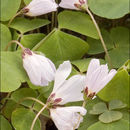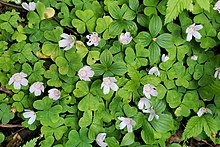Comments
provided by eFloras
Wood sorrel is not a common plant here. Grows in shady places at altitudes from 1200-2500 m. Used as an antiscorbutic. Occasionally cultivated in rockeries.
- license
- cc-by-nc-sa-3.0
- copyright
- Missouri Botanical Garden, 4344 Shaw Boulevard, St. Louis, MO, 63110 USA
Comments
provided by eFloras
This species is often misidentified, with robust forms attributable to Oxalis griffithii (which has a much thicker rhizome with dark brown scales and densely pubescent bracts) and slender forms attributable to O. leucolepis (which has thin rhizomes with widely spaced scales and glabrous, often rotund bracts). See Veldkamp (Fl. Males., Ser. 1, Spermat. 7(1). 1971) for discussions on O. acetosella sensu lato. Records from Zhongdian Xian and Lijiang Xian in Yunnan (X. Chuang, Fl. Yunnan. 5: 106. 1991) require confirmation.
- license
- cc-by-nc-sa-3.0
- copyright
- Missouri Botanical Garden, 4344 Shaw Boulevard, St. Louis, MO, 63110 USA
Description
provided by eFloras
Perennial 4—18 cm long. Rhizome elongated, knotted, scaly. Leaves radical; leaflets 12 35 mm long, 15—45 mm broad, emarginate; margin and lower surface with appressed hairs. Petiole 3.5—17 cm long, sparsely pubescent, base fleshy. Bracts 2, present half way up the peduncle. Sepals free, oblong lanceolate. Petals 10—15 mm long, white to pale pink. Filaments glabrous. Styles longer than the stamens. Capsule ovoid. Seeds few, longitudinally ribbed.
- license
- cc-by-nc-sa-3.0
- copyright
- Missouri Botanical Garden, 4344 Shaw Boulevard, St. Louis, MO, 63110 USA
Description
provided by eFloras
Perennials 8-15 cm tall, stemless. Rhizome creeping under-ground, slender, mostly covered with fleshy pale brown scalelike remains of leaf bases, ca. 1 mm thick not including scales, ca. 3 mm thick including scales; scales pale brown, sparsely strigose. Petiole 3-15 cm; leaflet blades obcordate, 0.5-2 × 0.8-3 cm, apex deeply emarginate; lobe apices rounded. Flowers solitary, nodding; peduncle as long as or longer than leaves; bracts at middle of flowering stalk, lanceolate, ca. 3 mm, with trichomes around apex. Sepals ovate-lanceolate, persistent. Petals white, lilac to pinkish veined, obovate, (1.2-)1.5-2.2 cm, apex retuse to deeply emarginate. Capsule angular-ovoid, 3-4 mm. Seeds light brown, ovoid, longitudinally ridged. Fl. Jul-Aug, fr. Aug-Sep. 2n = 22.
- license
- cc-by-nc-sa-3.0
- copyright
- Missouri Botanical Garden, 4344 Shaw Boulevard, St. Louis, MO, 63110 USA
Distribution
provided by eFloras
Distribution: North temperate Europe, North America, North Africa, North and West Asia.
- license
- cc-by-nc-sa-3.0
- copyright
- Missouri Botanical Garden, 4344 Shaw Boulevard, St. Louis, MO, 63110 USA
Distribution
provided by eFloras
Heilongjiang, Jilin, Liaoning, Ningxia (Liupan Shan), Xinjiang [Japan, Korea, Mongolia, Nepal, Pakistan, Russia; Europe].
- license
- cc-by-nc-sa-3.0
- copyright
- Missouri Botanical Garden, 4344 Shaw Boulevard, St. Louis, MO, 63110 USA
Flower/Fruit
provided by eFloras
Fl. Per. April May.
- license
- cc-by-nc-sa-3.0
- copyright
- Missouri Botanical Garden, 4344 Shaw Boulevard, St. Louis, MO, 63110 USA
Habitat
provided by eFloras
Forests, shady places; 800-3700 m.
- license
- cc-by-nc-sa-3.0
- copyright
- Missouri Botanical Garden, 4344 Shaw Boulevard, St. Louis, MO, 63110 USA
Synonym
provided by eFloras
Oxalis vulgaris
- license
- cc-by-nc-sa-3.0
- copyright
- Missouri Botanical Garden, 4344 Shaw Boulevard, St. Louis, MO, 63110 USA
Comprehensive Description
provided by North American Flora
Oxalis acetosella L,. Sp. PI. 433. 1753
Oxalis longiflora L. Sp. PI. 433. 1753.
Oxalis americana Bigel.; DC. Prodr. 1 : 700. 1824.
Plants 3-10 cm. tall, with slender rootstocks ; leaves erect or ascending, the petioles slender, sparingly villous, the leaflets 1.5-2.5 cm. broad, with scattered hairs on both sides; cleistogamous flowers nodding, the peduncles shorter than the petioles ; petaliferous flowers erect, the peduncles longer than the petioles ; sepals of the petaliferous flowers oblong to oblong-lanceolate, 4-5 mm. long, ciliate; petals 10-16 mm. long, white or pink and striped with deep-pink or purple especially near the base ; gynoecium glabrous or nearly so ; capsules of the petaliferous flowers ovoid-globose, 3-4 mm. long, those of the cleistogamous flowers shorter and broader.
Type locality : Europe.
Distribution : Nova Scotia to Manitoba, and southward on or near the mountains to North Carolina and Tennessee. Also in Europe and Asia.
- bibliographic citation
- John Kunkel Small, Lenda Tracy Hanks, Nathaniel Lord Britton. 1907. GERANIALES, GERANIACEAE, OXALIDACEAE, LINACEAE, ERYTHROXYLACEAE. North American flora. vol 25(1). New York Botanical Garden, New York, NY
Oxalis montana
provided by wikipedia EN
Oxalis montana is a species of flowering plant in the family Oxalidaceae known by the common names mountain woodsorrel, wood shamrock, sours and white woodsorrel. It may also be called common woodsorrel, though this name also applies to its close relative, Oxalis acetosella.
This species is a perennial herb native to eastern North America, including eastern Canada and the north-central and eastern United States, and Appalachian Mountains.[1] The Latin specific epithet montana refers to mountains or coming from mountains.[2]
Description
Oxalis montana is a perennial herb which grows in patches connected by subterranean rhizomes. There are no stems, just clumps of leaves growing to about 10 centimetres (3.9 inches) in maximum height.
The leaves are each made up of three heart-shaped leaflets.[1] The leaflets move, folding and unfolding, in response to sunlight.[3]
There are two types of flowers, blooms that open and cleistogamous flowers that remain closed and self-pollinate.[4] The flower color is variable. Environmental factors may cause variation; flowers growing at higher elevations have less color in the veins on the petals, while the veins of those at lower elevations have a deeper pink-purple coloration.[5] The fruit is a capsule. The plant reproduces sexually by seed and asexually by sprouting large colonies from the rhizome.[1] Some populations produce no flowers in a given season and reproduce only vegetatively.[4]
Ecology
This plant is a climax species, occurring in mature forests and tolerant of shade. It is a dominant herb in a number of ecosystems, such as the forests of the Appalachian Mountains. It occurs there in the understory of red spruce (Picea rubens) and balsam or Fraser fir (Abies balsamea or A. fraseri).
It is also dominant in northern hardwood forest habitat and its ecotones, in the understory of red or sugar maple (Acer rubrum or A. saccharum), yellow birch (Betula lutea), and American beech (Fagus grandifolia). Other dominant understory species growing with it include false lily-of-the-valley (Maianthemum canadense), goldthread (Coptis groenlandica), starflower (Trientalis borealis), and woodferns (Dryopteris spp.).[1]
This plant's extensive root network helps it stabilize the soil. It can grow on flat ground or steep slopes. The climate is often cool and moist, with high humidity and precipitation, including fog drip, and areas of long-lasting snowpack. Wildfire is uncommon.[1]
Uses
The species is sour in flavor, and can be added to soup or salad. It contains oxalic acid, which can be poisonous in high quantities.[6]
References
-
^ a b c d e Pavek, Diane S. (1992) Oxalis montana. In: Fire Effects Information System, [Online]. U.S. Department of Agriculture, Forest Service, Rocky Mountain Research Station, Fire Sciences Laboratory. Retrieved 12-04-2011.
-
^ Archibald William Smith A Gardener's Handbook of Plant Names: Their Meanings and Origins, p. 239, at Google Books
-
^ Comerro, H. K. and G. Briggs. (2000). Effects of leaflet orientation on transpiration rates and water potentials of Oxalis montana. SUNY Geneseo Journal of Science and Mathematics. 1(1) 7-10. Retrieved 12-04-2011.
-
^ a b Jasienuik, M. and M. J. Lechowicz. (1987). Spatial and temporal variation in chasmogamy and cleistogamy in Oxalis montana (Oxalidaceae). American Journal of Botany 74(11) 1672-80. Retrieved 12-04-2011.
-
^ Gates, S. C. and H. W. Vogelmann. (1969). Variations in populations of Oxalis montana Raf. Bulletin of the Torrey Botanical Club 96(6) 714-19. Retrieved 12-04-2011.
-
^ Lyle, Katie Letcher (2010) [2004]. The Complete Guide to Edible Wild Plants, Mushrooms, Fruits, and Nuts: How to Find, Identify, and Cook Them (2nd ed.). Guilford, CN: FalconGuides. pp. 29–30. ISBN 978-1-59921-887-8. OCLC 560560606.

- license
- cc-by-sa-3.0
- copyright
- Wikipedia authors and editors
Oxalis montana: Brief Summary
provided by wikipedia EN
Oxalis montana is a species of flowering plant in the family Oxalidaceae known by the common names mountain woodsorrel, wood shamrock, sours and white woodsorrel. It may also be called common woodsorrel, though this name also applies to its close relative, Oxalis acetosella.
This species is a perennial herb native to eastern North America, including eastern Canada and the north-central and eastern United States, and Appalachian Mountains. The Latin specific epithet montana refers to mountains or coming from mountains.
- license
- cc-by-sa-3.0
- copyright
- Wikipedia authors and editors


